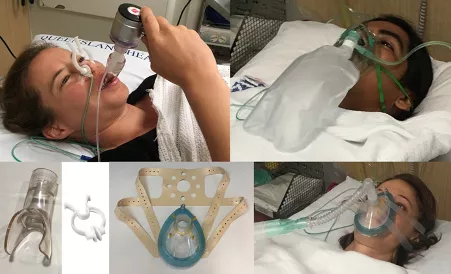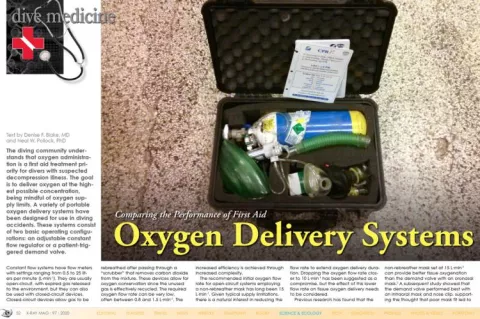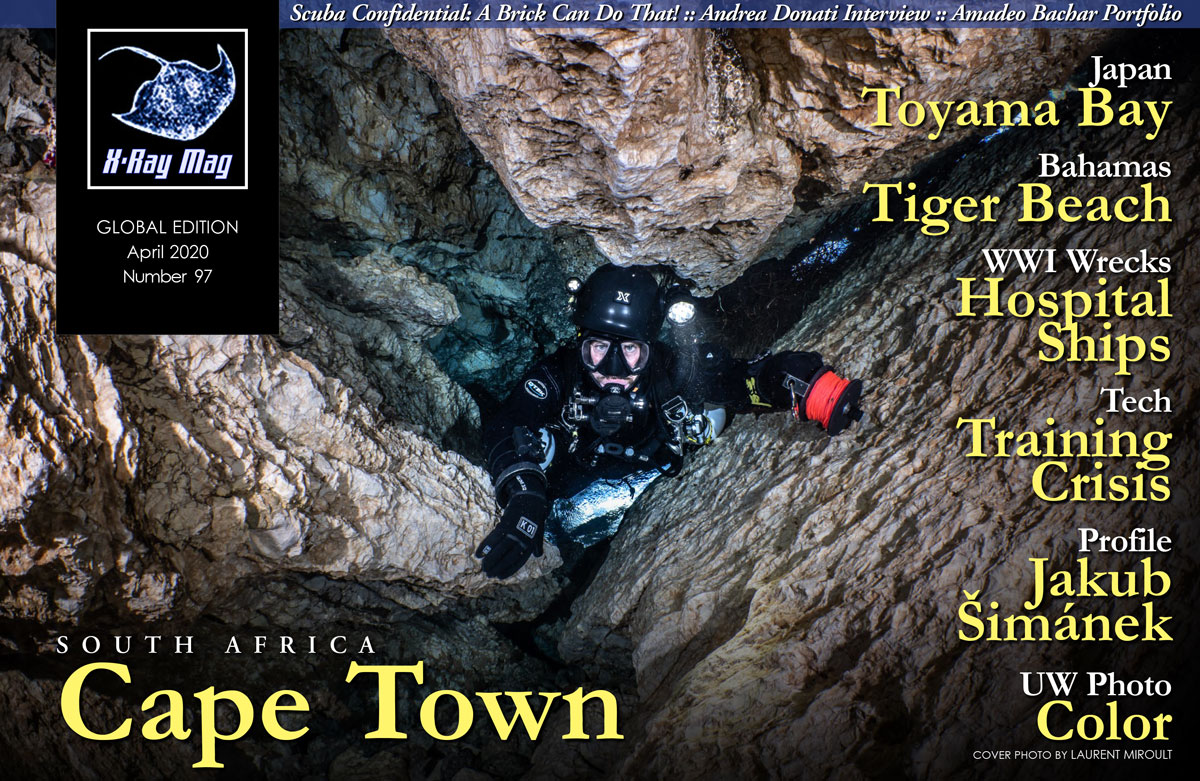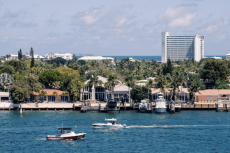The diving community understands that oxygen administration is a first aid treatment priority for divers with suspected decompression illness. The goal is to deliver oxygen at the highest possible concentration, being mindful of oxygen supply limits.
Contributed by
Factfile
Dr Denise F. Blake is an emergency and diving physician in Townsville, Queensland, Australia. This research is part of her current PhD program at James Cook University.
Dr Neal W. Pollock is an associate professor in Kinesiology at Université Laval, Québec, Canada.
The authors acknowledge research grant support from the Emergency Medicine Foundation (EMF), Queensland and in-kind support from Divers Alert Network Asia-Pacific. Thanks to Chris Chivers for the graphic design (Figure 4).
References
1 Blake DF, Naidoo P, Brown LH, Young D, Lippmann J. A comparison of the tissue oxygenation achieved using different oxygen delivery devices and flow rates. Diving Hyperb Med. 2015;45(2):79-83.
2 Blake DF, Crowe M, Lindsay D, Brouff A, Mitchell SJ, Pollock NW. Comparison of tissue oxygenation achieved breathing oxygen from a demand valve with four different mask configurations. Diving Hyperb Med. 2018;48(4):209-17.
3 Blake DF, Crowe M, Lindsay D, Brouff A, Mitchell SJ, Leggat PA, Pollock NW. Comparison of tissue oxygenation achieved breathing oxygen using different delivery devices and flow rates. Diving Hyperb Med. 2020;50(1): 34-42.
A variety of portable oxygen delivery systems have been designed for use in diving accidents. These systems consist of two basic operating configurations: an adjustable constant flow regulator or a patient-triggered demand valve.
Constant flow systems have flow meters with settings ranging from 0.5 to 25 liters per minute (L∙min-1). They are usually open-circuit, with expired gas released to the environment, but they can also be used with closed-circuit devices. Closed-circuit devices allow gas to be rebreathed after passing through a “scrubber” that removes carbon dioxide from the mixture. These devices allow for oxygen conservation since the unused gas is effectively recycled. The required oxygen flow rate can be very low, often between 0.8 and 1.5 L∙min-1. The increased efficiency is achieved through increased complexity.
The recommended initial oxygen flow rate for open-circuit systems employing a non-rebreather mask has long been 15 L∙min-1. Given typical supply limitations, there is a natural interest in reducing the flow rate to extend oxygen delivery duration. Dropping the oxygen flow rate closer to 10 L∙min-1 has been suggested as a compromise, but the effect of this lower flow rate on tissue oxygen delivery needs to be considered.
Previous research has found that the non-rebreather mask set at 15 L∙min-1 can provide better tissue oxygenation than the demand valve with an oronasal mask.1 A subsequent study showed that the demand valve performed best with an intraoral mask and nose clip, supporting the thought that poor mask fit led to the underperformance of the demand valve in the earlier research.2
This article summarizes the oxygen delivery achieved with three different commercially available oxygen delivery configurations. Additional details are available in the published report.3
Methods
Five different oxygen delivery configurations were tested: a demand valve with an intraoral mask (NuMask®) and nose clip; a first aid medical oxygen rebreathing system (MORS) (Wenoll-System, EMS GmbH, Möhrendorf, Germany) with an oronasal mask or with an intraoral mask and nose clip; and a non-rebreather mask with oxygen flow set at 10 or 15 L∙min-1 (Figure 1).
When using the demand valve, participants were asked to breathe deeply enough to trigger the valve. The MORS circuit was primed with oxygen at 40 L∙min-1 and the oxygen flow rate then set at 1.5 L∙min-1 (in accordance with the manufacturer’s instructions). The non-rebreather mask was positioned and adjusted to obtain the best seal possible. Participants were asked to breathe normally.
Oxygen delivery was measured in two ways: as the fraction of oxygen reaching the back of the throat (nasopharynx) and as tissue oxygen levels measured through the skin with transcutaneous oximetry. For the latter, sensors were taped on the skin at six standard sites (arm and leg), the skin was warmed to ensure good blood flow, and peak tissue oxygen levels were recorded non-invasively at the end of 10-minute oxygen breathing periods.
Following each trial, participants were asked to rate the mask configuration for comfort, ease of breathing, and ease of holding the apparatus in place.
Results
Data were collected using 12 healthy volunteer diver-participants (nine female; three male) under dry laboratory conditions.
The highest levels of nasopharyngeal oxygen were achieved with the non-rebreather mask at 15 L∙min-1 oxygen flow. The demand valve delivered slightly less, and the non-breather mask at 10 L∙min-1 delivered the lowest levels. The delivered fraction required more time to reach peak levels with the MORS and the non-rebreather mask with a 10 L∙min-1 flow rate (Figure 2).
The tissue oxygen levels ultimately achieved were statistically similar for the non-rebreather mask at 15 L∙min-1, the demand valve with intraoral mask and nose clip, and MORS with either the oronasal mask or the intraoral mask. The non-rebreather mask with 10 L∙min-1 was the poorest performer (Figure 3).
Subjectively, the non-rebreather mask was rated as the most comfortable, easiest to breathe through, and overall easiest to use.
Discussion
There are many portable oxygen delivery systems designed to provide effective first aid oxygen to injured divers. Evaluating tissue oxygen levels is probably the most meaningful way to assess effectiveness. Our findings confirm that the three systems evaluated can provide similar tissue oxygenation, but that oxygen flow rate and configuration can play an important role.
When providing oxygen with an open-circuit non-rebreather mask, oxygenation was significantly influenced by oxygen flow rate. Given the critical goal of providing divers with the highest oxygen concentration possible (close to 100%), 15 L∙min-1 flow rates should be used when practical. Monitoring the reservoir bag for constant inflation, as suggested in oxygen training courses, does not guarantee high levels of oxygen delivery. The higher oxygen flow rate likely provides enough oxygen directly during the inspiratory period to deliver a higher oxygen content.
When providing oxygen with a demand valve, an intraoral mask is known to be effective.2 The use of an intraoral mask may be a better option for divers with large amounts of facial hair or other conditions that may impair an oronasal mask seal. If an intraoral mask is not available, a regulator mouthpiece could also be used. A standard regulator mouthpiece is included with the MORS.
The MORS may be a good choice when the oxygen supply is limited, or if access to additional medical supplies and/or care is likely to be delayed. A Jumbo D size oxygen cylinder (640 liters) may last for up to 6 hours (1.5 L∙min-1 x 60 min then 0.8 L∙min-1) when using the MORS.
Several other factors should be considered when selecting oxygen delivery equipment, including cost, availability, local regulations and training and maintenance requirements. Figure 4 provides a summary of factors for comparison.
The MORS regulator is multi-function with a demand valve and constant flow settings from 0.5 to 15 L∙min-1 allowing it to be used with either the rebreather circuit or a non-rebreather mask. The MORS circuit is sold as a single-use device, requiring replacement after every use or after four years of storage due to the life expectancy of the scrubber material. Its replacement cost is considerably more than the disposable parts of the other systems (MORS circuit €175 ($192USD), intraoral mask with nose clip €10 (US$11), non-rebreather mask €4.5 (US$5)).
Numerous organizations provide emergency oxygen therapy courses for use of the demand valve and non-rebreather mask. At present, courses for the MORS are only offered in Europe, but the system does come with a comprehensive operating manual. With the growing popularity of closed-circuit rebreathers for diving, there may be an increased interest in MORS systems for first aid use.
Rescuers may have to manage potentially complex situations, including those with unconscious, non-breathing patients. A non-rebreather mask cannot be used for a non-breathing patient, but the oxygen tubing can be removed from a non-rebreather mask and attached to the inlet port of a pocket face mask to improve oxygenation during mouth-to-mask resuscitation. Similarly, while standard scuba regulators should not be used to manually ventilate a patient due to the high purge valve pressures that can cause tissue damage or promote regurgitation of material from the stomach, some medical oxygen delivery systems are designed to be used safely. Some closed-circuit systems may also have adjustable pressure limiting valves to allow ventilation of a non-breathing patient.
Appropriate training is important to ensure knowledge of the strengths and limitations of any delivery system, and ongoing practice is needed to ensure physical skill readiness during emergent events.
Conclusion
Three devices (in five conditions) were tested for their ability to deliver oxygen to simulated patients. Oxygen levels were highest with a constant flow system paired with the non-rebreather mask and a 15 L∙min-1 flow rate, and lowest with the non-rebreather mask at 10 L∙min-1. MORS with either an oronasal mask or mouthpiece may provide an alternative for prolonged oxygen delivery with limited gas supply. ■

























